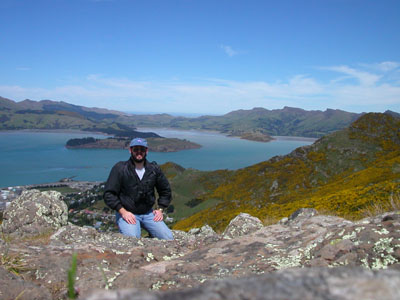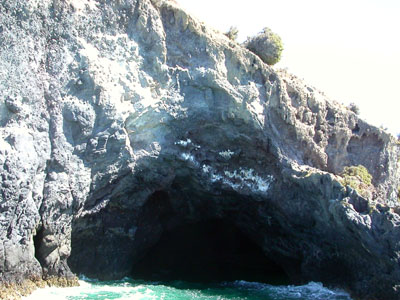|
TIGER in Antarctica, November 10, 2003
Exploring the Area
 First thing in the morning, I head to the Antarctic Center so that I can check my email. Then it's out of town to explore. The Christchurch bus system is quite nice, and an all day pass is only 7$NZ. When I was here two years ago, I cruised around the area quite a bit, but I didn't get to the gondola that goes up a ridge outside of town and the Lyttelton Harbor beyond it. So that's the goal for today.
First thing in the morning, I head to the Antarctic Center so that I can check my email. Then it's out of town to explore. The Christchurch bus system is quite nice, and an all day pass is only 7$NZ. When I was here two years ago, I cruised around the area quite a bit, but I didn't get to the gondola that goes up a ridge outside of town and the Lyttelton Harbor beyond it. So that's the goal for today.
The gondola ride isn't very long or very high, but there is a nice view of the city on the one side. You can see it in behind this gondola picture. Christchurch sits on alluvial plains from the New Zealand Southern Alps that you can see in the distance.
The gondola outside of Christchurch
 Just south of Christchurch are the weathered remains of two old volcano craters (and a whole bunch of side vents). These craters have filled in with sea water and are now Lyttelton and Akaroa bays. I went to Akaroa on my last trip (it's about an hour and a half drive). Lyttelton is closer. You look down on it from the top of the ridge that the gondola takes you to.
Just south of Christchurch are the weathered remains of two old volcano craters (and a whole bunch of side vents). These craters have filled in with sea water and are now Lyttelton and Akaroa bays. I went to Akaroa on my last trip (it's about an hour and a half drive). Lyttelton is closer. You look down on it from the top of the ridge that the gondola takes you to.
Lunch at the gondola restaurant was mediocre. The fries were good, the chicken nuggets were questionable (what part of the chicken is the "nugget"? Chickens don't have nuggets). Then hop on another bus through a tunnel in the ridge to the harbor.
Looking down on Lyttelton Harbor
 Lyttelton is a pretty industrial port town with nice residential areas on the hills surrounding it. They run a few sightseeing boats out of Lyttelton (it's mostly lumber, coal, natural gas, and other cargo, and fishing), so I buy a ticket for an afternoon wildlife cruise. The big draw are Hector's dophins, an endangered species and the smallest dolphins in the world. Adult females are only 1.4 - 1.6 meters and adult males are even smaller. We are told that infants are only slightly larger than a rugby ball, but don't see any.
Lyttelton is a pretty industrial port town with nice residential areas on the hills surrounding it. They run a few sightseeing boats out of Lyttelton (it's mostly lumber, coal, natural gas, and other cargo, and fishing), so I buy a ticket for an afternoon wildlife cruise. The big draw are Hector's dophins, an endangered species and the smallest dolphins in the world. Adult females are only 1.4 - 1.6 meters and adult males are even smaller. We are told that infants are only slightly larger than a rugby ball, but don't see any.
A Hector's Dolphin
 We see a couple of pods of dolphins which come right up to the boat. It is really hard to take good pictures of them with my digital camera (and I left my 35 mm back in town). There is a long delay between pressing the button and the picture taking and you have to anticipate their surfacing because they are moving so fast.
We see a couple of pods of dolphins which come right up to the boat. It is really hard to take good pictures of them with my digital camera (and I left my 35 mm back in town). There is a long delay between pressing the button and the picture taking and you have to anticipate their surfacing because they are moving so fast.
another dolphin
 We cruise right out of the bay at high speed and the catamaran is actually taking air, although the swells aren't that big. We head down the coast a little way to check out some nesting sea birds. The white patches just above this sea cave are guano from all the bird nests, and on the large version, you can see the birds nesting there.
We cruise right out of the bay at high speed and the catamaran is actually taking air, although the swells aren't that big. We head down the coast a little way to check out some nesting sea birds. The white patches just above this sea cave are guano from all the bird nests, and on the large version, you can see the birds nesting there.
Back to harbor along the coast includes a historical narrative pointing out the old whaling camps and immigrant quarantine sites.
A Sea Cave with nesting Spotted Cormorants
Back to town for a light dinner (New Zealand Green-Lipped Mussels and Seafood Chowder) and bed.
Dr. Eric R. Christian
NASA HQ Code SS
Washington, DC
20546 USA
This page was last modified on November 12, 2003 |